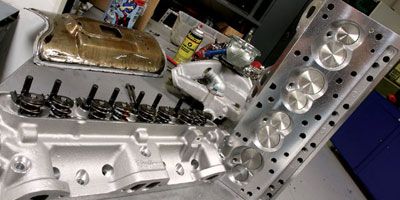
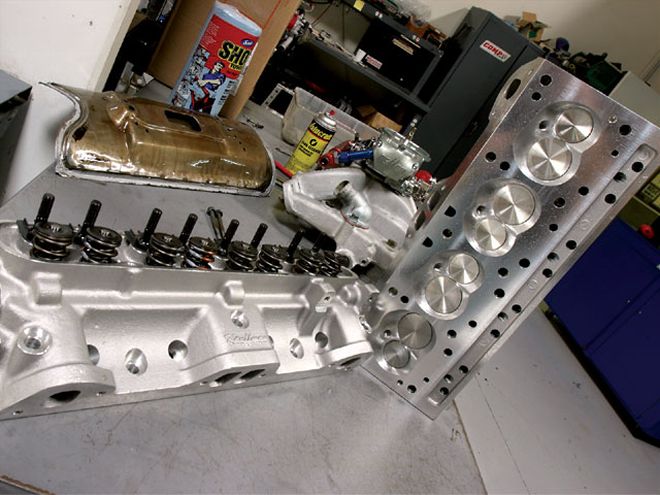
Several years ago, we spotted a Pontiac 455 in the Pick Your Part and nabbed it, knowing that it was getting increasingly difficult to find the biggest of the Poncho mills. The idea was simply to obtain a good core, but the subsequent peek inside revealed that the engine was actually in pretty decent shape. We cleaned it, tuned it, and ran it on the dyno, starting with the pathetic stock stuff from 1976, the final year of the 455, and ending up nearly doubling the engine's output with bolt-ons (see "Junker to Thumper," June '03).
The next phase was going to be the proper rebuild, but as we were procrastinating over that, more Pontiac speed parts continued to flow into the marketplace. Of particular interest were the relatively new Kauffman Racing Equipment aluminum heads. Once they hit the shelves, we got all hot and bothered to dyno-flog them, and being the impatient lot that we are, we didn't want to wait to freshen the big Pontiac, so we figured we'd set 'er up again and see if our mule could handle another dyno session. There were some fears over potentially wrecking our nice core 455, but we figured if we didn't get crazy, it would hold together one more time. It did, and we got our numbers. Want to see if the new aluminum D-port heads are worth it? Read on.
The Deal With D-Ports
In the world of Pontiac performance, there's pretty much one engine family to focus on: The V-8 introduced for 1955 and produced through 1979. There is no big- or small-block, with all displacements from 326 to 455 being based on the same block architecture; the only significant change to the design came for 1965, and this was a minor cylinder-head alteration that requires a corresponding intake manifold. Since most performance Pontiac engine builds are based on engines produced since 1965, this is usually a non-issue.
The only other major variation in Pontiac V-8s is found in the exhaust ports, and here you have a choice of round-port or D-port. Round-port heads are exotic stuff only used on the highest-performance Pontiac engines offered while D-ports are the standard fare found on everything else. The round-port first appeared for 1968 as part of the Ram Air II engine option for GTOs and Firebirds; the next year saw the introduction of the most desirable round-port factory head, the Ram Air IV. Subsequent use of round-port heads include the '71-'72 455 HO and the '73-'74 SD 455.
Previously released aftermarket heads for Pontiac V-8s, like those from Edelbrock and the Wenzler, use the round-port design. It makes sense that an aftermarket performance head would start with the best offered by the factory and get enhanced from there, but there are lots of Pontiac guys who don't want to have to change headers and possibly parts of the exhaust system. That may not sound like a big deal, but there actually aren't that many different headers offered for the round-port, and those that are don't cover all body styles. Guys who spent bucks to purchase reproduction Ram Air exhaust manifolds for D-ports, like those intended for the '69-'70 Ram Air III, are also not that happy about the prospect of having to shelve them-they don't come cheap. For these reasons and others, Kauffman felt a need existed for an aluminum alternative.
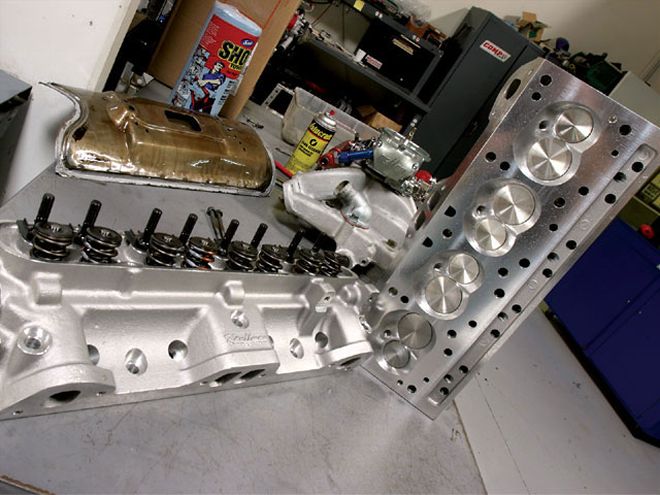
Edelbrock patterned its Performer RPM aluminum Pontiac cylinder heads on Pontiac's '69-'70 Ram Air IV casting, which used the round-port flange. The side-by-side comparison illustrates that the difference in exhaust-outlet design isn't just in the shape of the ports, but the flange bolt pattern as well. The Edelbrock version of the round-port is flat on the bottom, but the dark circles of carbon represent Pontiac's intended dimensions.
The Aluminum D-ports
Aiming at the mainstream Pontiac street/strip market, Kauffman Racing Equipment (KRE) felt that designing a set of bolt-on aluminum D-port heads would be a worthwhile endeavor, not simply to shave weight, but to take advantage of modern cylinder-head technology. Strides made in port and chamber design since 1955 have been enormous and stand to benefit the Pontiac V-8 in particular, since even the last versions from the late '70s were not that different from the originals. Aftermarket cylinder-head designers often focus on port improvements, but increasing the efficiency of the combustion chambers can transform the engine's performance characteristics entirely, and on the traditional Pontiac, this is an area where factory designs leave a lot to be desired.
The KRE heads use a modern heart-shaped combustion chamber to promote swirl and increase quench. In addition, the spark plug has been moved closer to the center of the chamber to promote a faster burn. These techniques are common to late-model engines. An illustration of what happens when newer chamber technology is applied to older engines can be seen in the Chevrolet Vortec heads, which allow 50-year-old small-block Chevys to make significantly more power with the same displacement, compression, and valve sizes while also gaining octane tolerance-that means more power on cheap gas. Part of the KRE plan was to bring these benefits to the Pontiac V-8.
Standard valve sizes for the KRE D-port heads are 2.11/1.66 inches-this is what our test heads have, and it's the same as Pontiac used on later factory heads. Optional are 2.11/1.77-inch valves, as found on '65-to-mid-'70s factory heads; an additional option of 2.19/1.66 inches is also offered. The KRE heads are also built to accept 1.65:1 rocker arms without modifying the pushrod tubes. Combustion chambers can be ordered in 65 cc (considered race-spec), 74 cc, or 85 cc, the latter two being CNC-machined.
Despite the improvements, KRE states that these heads maintain the same valve centers as a stock Pontiac D-port and are designed to use all the stock parts and hardware with the exception of the head bolts, which are produced by ARP. And even though it wasn't really a design goal, the aluminum D-ports manage to shave nearly half the weight of the iron stockers.
The Baseline: Iron D-ports
To establish a baseline for a typical street 455, we located a set of D-ports that would create a mid-9.0:1 compression ratio on our mule motor. This can be a bit tricky, as Pontiac never actually offered a 455 with 9.5:1, having started with 10.25:1 in 1970 and skipping all the way down to 8.5:1, then to 8.2:1, and finally to an insulting 7.6:1 for the last couple years. However, since Pontiac used flat-top pistons in most of its engines and manipulated compression ratio with combustion-chamber volume, dialing in the right ratio is a matter of finding the right heads. In this case, we needed something in the neighborhood of 96 cc's instead of the 124 cc of our original heads. Fortunately, some early '70s 400s have exactly what we needed. Pontiac guys have sought out the casting number 96 heads from a '71 400 two-barrel motor for years, since they have the potential to make about 9.5:1 on a 455. We happened to find a set of 7K3 heads from a '72 400 that also have 96cc chambers. We thought we'd scored, since the newer heads even have heat-treated valve seats for unleaded gas, but then Ken Crocie of H-O Enterprises pointed out that these castings are among several that don't have the outer exhaust bolt holes, or the bosses to drill them, making header use a problem.
But, for the sake of our dyno test the 7K3 castings would still do the job. We took the hideous junkyard score to JMS Racing Engines in Monrovia, California, for a quick cleanup and rebuild. Once reassembled, the 7K3 heads were ready to establish a baseline for a typical iron-headed street 455.
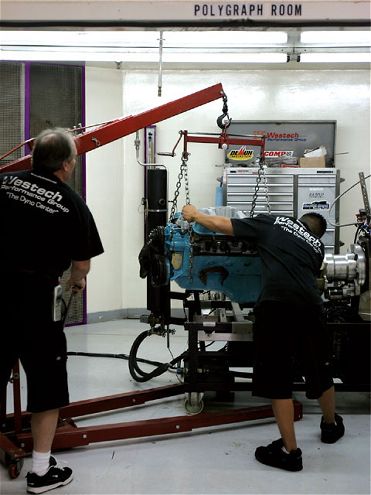 The 455 was returned to the dyno, sans rebuild, but with yet another set of heads. The iron 400 heads made a bit over 9.0:1 and gave us no trouble, even with nonadjustable rockers and an aftermarket cam. Still, this many inches should make over 400 hp but didn't . . . yet.
The 455 was returned to the dyno, sans rebuild, but with yet another set of heads. The iron 400 heads made a bit over 9.0:1 and gave us no trouble, even with nonadjustable rockers and an aftermarket cam. Still, this many inches should make over 400 hp but didn't . . . yet.
On the Dyno Iron D-ports
The 455 mule was assembled with the 7K3 heads using Corteco gaskets and stock Pontiac head bolts. With the original pistons 0.015 inch in the hole, the 96cc combustion chambers, and the 0.036-inch compressed thickness of the head gasket, compression was right around 9.2:1. The Comp Cams XE274H hydraulic cam remained from our last Pontiac dyno session. The grind features 230/236 degrees duration at 0.050-inch lift and 0.488/0.491-inch lift on a 110-degree lobe separation angle. Stock-type pushrods were used with Pontiac 1.5:1 stamped-steel, nonadjustable rocker arms, mainly because our rollers wouldn't fit the stock studs of the 7K3 heads. Despite the lack of adjustment, the stock rockers seemed to attain the proper preload when tightened to factory specs.
Once the engine was mounted on the dyno at Westech, we topped the Edelbrock Performer RPM intake with a Speed Demon 825-cfm carb. We were about to use a set of "three-tube" cheapie headers since that's all we could get our hands on in time when Ken Crocie of H-O Enterprises came to the rescue with a set of D-port 151/48-inch long-tube headers. As it turns out, Ken's no-frills Summit headers were pretty economical at $99.50 and worked perfectly.
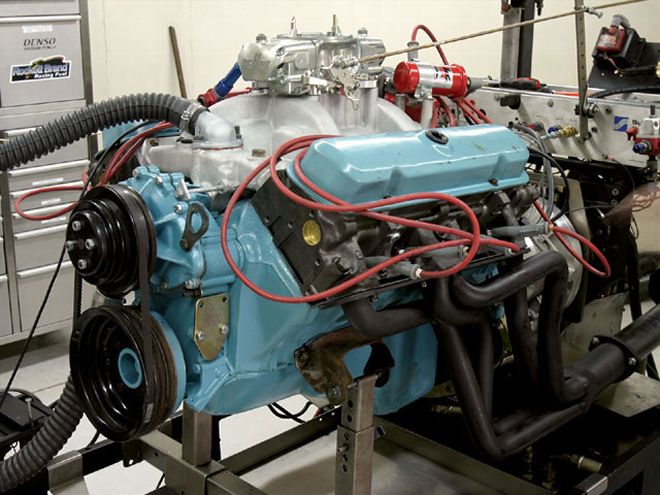
With the MSD Ready-to-Run distributor dialed in, the 455 fired up and was soon making power. After a series of pulls and some tuning, we found the sweet spot with 37 degrees total timing and 83/87 jetting in the Demon. With this combo, we averaged our best runs to obtain a peak power figure of 390 hp at 4,700 rpm and 494 lb-ft at 3,500. Note that the engine was grunting out 450 lb-ft at the start of the pull at 2,500 rpm.
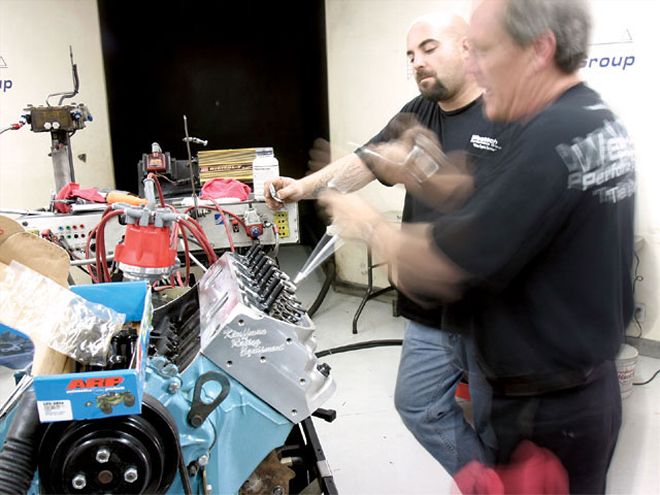 The KRE aluminum D-ports are a simple swap-the only oddity is the special-length bolts, but ARP makes them. We had to use roller rockers, but we kept the ratio the same. Don't try to tell us these made the 40hp difference.
The KRE aluminum D-ports are a simple swap-the only oddity is the special-length bolts, but ARP makes them. We had to use roller rockers, but we kept the ratio the same. Don't try to tell us these made the 40hp difference.
Kauffman D-ports
The KRE heads swapped on easily, using the application-specific ARP bolts and another set of Corteco gaskets. The 85cc chambers should have raised the compression to around 9.8:1-less than the full point of increase often recommended when switching to aluminum, but a nice safe pump-gas ratio nonetheless. This time, due to the larger rocker studs of the KRE heads and some poor planning on our part, we used a set of Comp Cams roller rockers, though the ratio remained at 1.5:1. With the fresh synthetic lube we were using and the relatively mild cam and resulting sub-5,000-rpm engine speeds, it seemed unlikely that an appreciable power advantage would result from the rollers, so we pushed ahead. The same induction, exhaust, and ignition components were returned to the 455 for the aluminum-head tests.
When the 455 was running again, we didn't expect to notice much difference outside of the dyno readouts after the pulls, but the engine seemed crisper on tip-in, and more willing to rev. Moments later, the confirmation was on screen-the 455 was up significantly. We'd backed the timing up to 34 degrees to be safe, but putting more lead in made no more power. In fact, the engine wound up happiest with a mere 33 degrees-an indication that the revised chambers were indeed more efficient. Once we found the best tune and made some back-up pulls, our calculated average peak power figure came in at 427 hp at 4,500 rpm and 540 lb-ft at 3,700. Just shy of a solid 40hp gain coupled with 45 extra pound-feet of torque.
Dyno Dyno
Test 1 is the 455 with 7K3 factory iron heads (96 cc), Comp Cams XE274H cam, Edelbrock Performer RPM intake, Speed Demon 825-cfm carb, and Summit four-tube full-length headers. Compression is 9.2:1 and total timing is 37 degrees.
Test 2 is the 455 with the KRE aluminum D-port heads (85 cc) and all of the same equipment used in test 1. Compression is 9.8:1 and total timing is 33 degrees.
TEST 1 TEST2 DIFF RPM TQ HP TQ HP TQ HP 2,500 450 214 465 222 15 8 2,{{{600}}} 448 222 462 229 14 7 2,700 452 233 466 {{{240}}} 14 7 2,800 456 243 477 255 21 12 2,{{{900}}} 461 255 490 271 29 16 3,000 469 268 502 287 33 19 3,{{{100}}} 476 281 511 302 35 11 3,{{{200}}} 485 296 519 317 34 21 3,{{{300}}} 489 307 526 331 37 24 3,400 492 319 531 344 39 25 3,500 494 329 537 358 43 29 3,600 493 338 539 370 46 32 3,700 492 347 539 380 47 33 3,800 490 355 537 389 47 34 3,900 487 362 535 398 48 36 4,000 483 368 530 404 47 36 4,100 480 375 523 409 43 34 4,200 473 379 516 413 43 34 4,300 465 381 509 417 44 36 4,400 458 384 504 422 46 38 4,500 452 387 498 427 46 40 4,600 444 389 486 426 42 37 4,700 435 390 471 422 36 32 4,800 423 387 456 417 33 30 4,900 413 385 442 413 29 28 5,000 396 377 430 410 34 33 5,100 384 373 419 407 35 34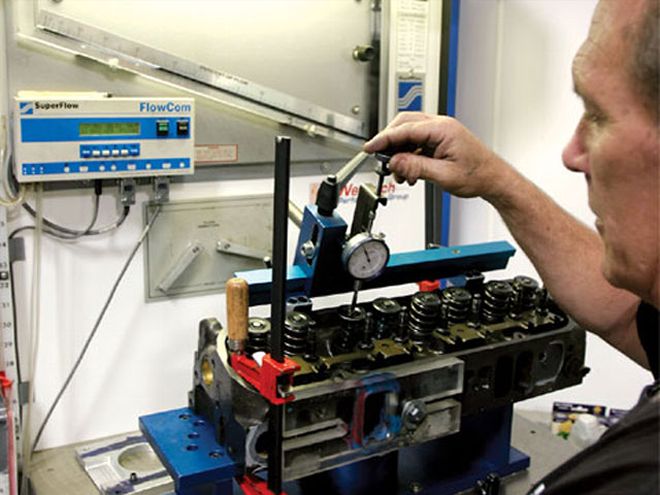
We flow-tested both the iron Pontiac heads and KREs on the same Superflow 600 flowbench at Westech used to test all CC's heads.
AIRFLOW CHART VALVE IRON 7K3 KRE ALUMINUM OPENING INT EXT INT EXT 0.050 38 24 33 26 0.{{{100}}} {{{80}}} 51 67 55 0.{{{200}}} 143 96 148 100 0.{{{300}}} 180 125 198 134 0.400 201 142 227 154 0.500 211 162 235 170 0.600 215 168 236 180 0.700 219 171 234 183 *Intake and exhaust results are in cfm.'If for some reason you want a set of 7K3 heads, JMS has another pair.